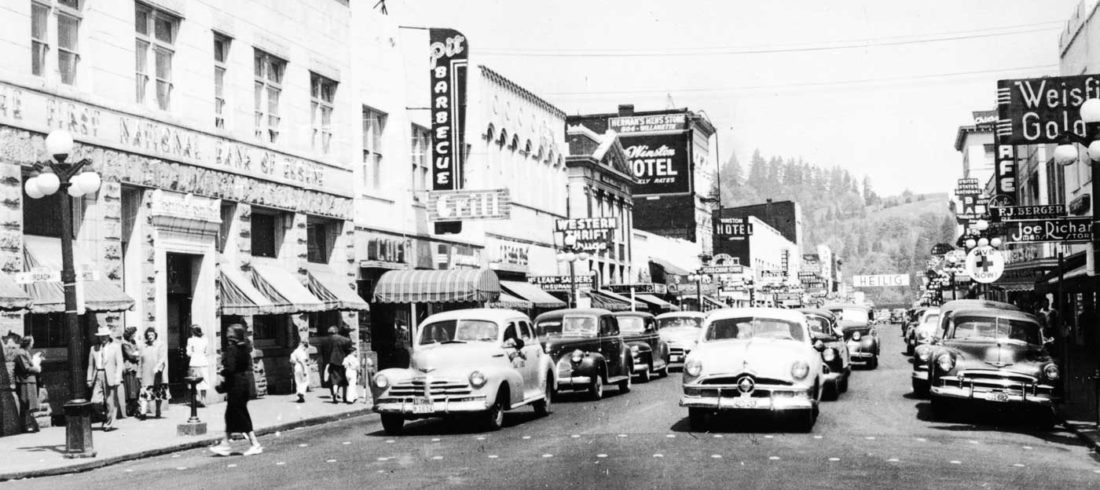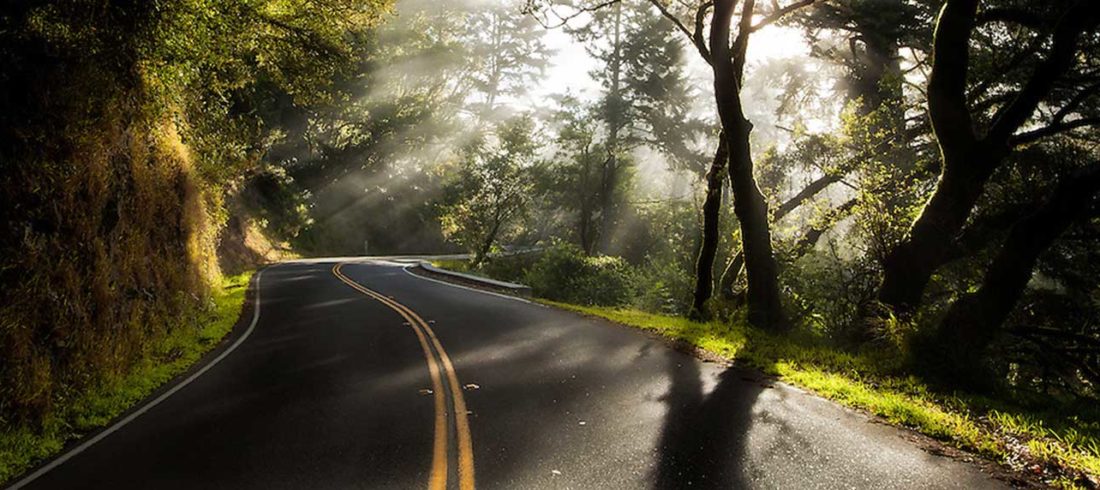America’s great love affair with the automobile is no simple thing. It’s morning rush hour in Eugene and I’m pondering the theme of local car culture as my dinged-up Honda CRV creeps toward signal lights controlling access to Randy Papé Beltline. Traffic congestion on sections of Beltline are a given most weekdays. So, too, are the random motorists with cell phones parked near their ears. This slow parade of vehicles? Mostly foreign cars, late-model SUVs, pickup trucks, a few family vans, and a smattering of domestic sedans. At best, my immediate observations represent only a thin slice of the Eugene-area car scene.
Like I said, romance is often complicated. And a totally roadworthy understanding of local car culture seems, well, far away this particular morning.
Still, the culture is there, and it’s plentiful: custom muscle car builders like the specialists at MetalWorks; car restoration specialists like Mark Worman and the crew of the cable TV series Graveyard Carz; local autocross events; car muralists who’ve rebuilt their work lives since the collapse of the local RV industry; a multitude of car clubs embracing everything from Beetles to beaters.
The more tires I kick to test my central themes about Eugene car culture, the more I realize there are way too many considerations. Too many cars on local streets and highways. Too many cars in garages, repair shops, parking lots, salvage yards, and showrooms. There’s no guarantee of a smooth ride to my literary destination.
Yet, as they say on the NASCAR circuit: “Drivers, start your engines!”
Form and function
George Rode (2018 Subaru Forester) is an expert mechanic. He’s also a stand-up guy. He operates three premier auto repair shops in Eugene (Euro-Asian Auto, Stadium Auto, and Autohaus), and he’s known for his advice to car owners via radio shows, local print media, and various other community forums.
“In Eugene,” Rode says, “we tend to go with more foreign cars than domestic cars. And smaller cars because of their modest impact and better mileage. I think there’s a sizeable group of people here who don’t think at all about status cars. There are also the basic, functional car folks. And then there are the ‘I really don’t care what I drive as long as it gets me from point A to point B’ folks.” Rode adds that Eugene also has a lot of environmentally friendly cars, boasting more Toyota Priuses per capita than most cities.

Guts and glories
Once there was “The Gut,” the section of Willamette Street stretching roughly from 18th Avenue to 32nd. Picture scenes straight out of American Graffiti: bumper-to-bumper weekend traffic; hot rods, ragtops, and family station wagons; burning tire rubber and blaring radios; car windows down and teenage hormones up.
The glory days of Eugene’s Gut phenomenon spanned the ’60s through the ’90s. It was a time when teenage dreams were married to after-school jobs and plans for buying that first car. A time when roadside flirtation and backseat petting were rites of passage. And car culture took you there on Friday nights, when everybody owned a piece of Willamette Street.
Gearing up green
Arcimoto’s all-electric FUVs (fun utility vehicles) have been quietly rolling down Eugene streets toward national visibility for 10 years. The promising three-wheel prototypes built previously in the company’s shop in the Whiteaker recently hit critical mass when it comes to small-scale production. Now, as Arcimoto’s ambitions have shifted to upscale vehicle production, Eugene suddenly has claim to a trendsetting car company.
Arcimoto isn’t the first electric vehicle company here, however. The Gizmo was first designed and produced in Eugene in the late ’90s as a tool for greener neighborhood travel. The three-wheel electric vehicle cost $12,000 and had room for one person plus a few shopping bags. Gizmos hit a top speed of 40 mph and consumed a penny’s worth of electricity per mile. The odd-looking electric trike, described by its manufacturer as “a cross between a bike and a Buick,” generated a modest buzz at the start of the millennium. Eugene Water & Electric Board even purchased a pair.
But that was then. These days, spotting a Gizmo on a neighborhood street is less likely than pulling alongside a Rolls Royce on Highway 99.
The same certainly can’t be said of bicycles. It’s widely known that much of Eugene and Springfield endorses bicycle use as an alternative to motor travel. And between the expanding network of local bike paths, the many bike retailers, up and coming bike share programs, and the bike racks and parking areas at community events and commercial building sites, bikes—relatively inexpensive and eminently sustainable—certainly merit at least passing consideration in any overview of the local car culture.
Tracking history
Those same latter decades also featured other car-centric activities in local communities. Speed and danger were hallmarks of popular racing venues. Cottage Grove had (and still has) an oval dirt track, as did West Eugene back in the day, including a drag strip! They were places for testing your “metal” as an aspiring driver and showcasing your prized street rod.
There was also a high-performance hometown racetrack in the mid-’60s. The paved quarter-mile oval sat in the field near Goshen where the county garbage landfill now resides. It attracted drivers from across the Northwest, racers who strapped in behind the steering wheels of sleek, sexy Triumphs, Lotuses, and formula cars. The three-year adventure ended when it was discovered that faulty design and damage from winter rains made track maintenance unaffordable.
Bob Macherione (2009 Jaguar S-Type) owns Sports Car Shop, a local car repair and sales showplace for high-end sports cars. Macherione knows volumes about collectable cars, especially European sports cars and racers. He’s also a bit of a historian on the Goshen track, with plenty of opinions about local car culture.
“In some respects, I think Eugene kind of lags behind other cities of similar size when it comes to car culture,” Macherione says. “If the track had survived, I think we’d have a whole different car culture here. We’d have a lot more road racing, a whole different group.”
Macherione also sees a certain social pressure in Eugene. “If you have money or if you’re old, established money, you don’t show your wealth,” he says. “It’s discouraged. You might buy an $80,000 Suburban, but you’re not going to be driving an Aston Martin around town. We have a healthy car scene, but it’s not a particularly diverse scene.”
Hot rods and classics
The Graffiti Alley parts store is a bit of a River Road landmark. Its owner, Bob White (1965 Chevy Suburban), has long been a force in local classic car circles. Back in the ’90s, White founded an annual gathering he labeled “The Function in Junction.” In short, he organized and promoted car shows combined with car cruises that often attracted nearly 400 vehicles. Every summer for 14 years, The Function had a home in Rasor Park, an open field adjacent to Graffiti Alley. Customized cars traveled back and forth along River Road from the park to Junction City. White says The Function died after he got tired of city bureaucrats regulating the events.
“The car scene here is really diverse,” says River Road Les Schwab manager Jason Gail (2011 Dodge Durango). “We see everything from low-end budget cars clear up to the top of the high end, Maseratis and the like. And restored classic cars. “We’ve got a tremendous car culture in this area,” adds White, “and Eugene is thick with car culture. There are some famous hot-rodders and racers from drag racing on up. Many of them live here but leave to attend car events in other places. Yeah, Eugene has a pretty rich car history.”

Old school interests
Brooks Auto Parts surely falls into the old school segment of local car culture. The barn-like warehouse in Glenwood started as a gas station 60 years ago. When the station’s trade in wiper blades, oil, and headlights eventually outgrew the station office, Brooks expanded its wares into the curious emporium of vehicle accessories that still remains pretty much intact today. “We’re the last of the old parts stores,” says Jolene Ortis (2014 Kia Soul), one of the store’s longtime employees.
And then there’s Jerry Szerlip (1946 Packard Limousine), a local mechanic, machinist, fabricator, and body restoration specialist with towering credentials in the classic car universe. Szerlip has built Indy racers and rebuilt a dizzying collection of exotic automobiles. He holds some of the most coveted awards attainable in the world of custom cars. Even then, at age 75, he’s still a modest, hard-working fellow.
“Awards are a byproduct of the work you do, an affirmation of the pride you take in your work,” suggests Szerlip. He says he reserves the privilege of choosing which people and projects he takes on. “I’m not in business to make money,” he says. “Sometimes my work is about seeing somebody light up, being pleased with what they get. To me, that’s worth as much as anything money can buy.”
Downshifting
A ride across the landscape of local car culture can illuminate many of the unique considerations that make Eugene the special place that it is. Whether you’re driven by interests in business, aesthetics, nostalgia, science, or social networking, Eugene’s car scene includes elements that fit your lifestyle well.
The engine is running. The doors are open. The seats are comfy. There’s always somewhere to go.


